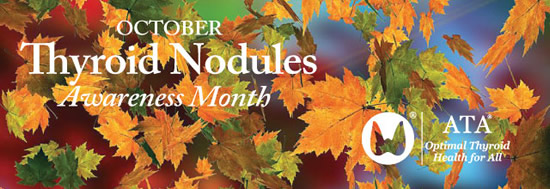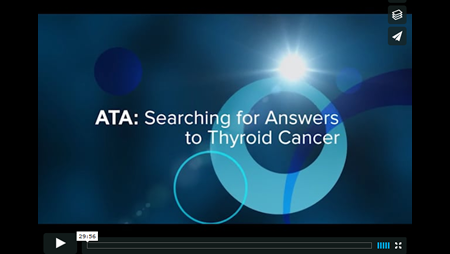Clinical Thyroidology for the Public summarizes selected research studies discussed in the previous month’s issue of Clinical Thyroidology, an official publication of the American Thyroid Association. Editor-in-chief, Alan Farwell, MD, FACE
Volume 12 Issue 10
Available in pdf format for saving and printing and Web page format for viewing online
PDF Format for Saving and Printing
Clinical Thyroidology for the Public Volume 12 Issue 10 (PDF file, 7.08 MB)
TABLE OF CONTENTS – Web Format
THYROID CANCER What Factors Contribute to Worse Quality of Life in Thyroid Cancer Survivors?
Although the death rate is much lower in patients with thyroid cancer than other cancers, recent studies have shown that the self-reported quality of life in these survivors is the same or worse than that reported in cancers with worse prognoses. Cancer survivors may experience changes in their physical or emotional state as a consequence of the diagnosis, treatment and monitoring of the cancer. This study obtained and analyzed patient-reported data to understand the illness from the patient’s perspective, so that effective interventions can be developed aimed to improve health related quality of life.
Goswami S et al 2019. Clinical factors associated with worse quality-of-life scores in United States thyroid cancer survivors 2019 Surgery. Epub 2019 Mar 18. pii: S0039- 6060(19)30066-2. PMID: 30898373.
(PDF File for saving and printing, 792KB)
THYROID CANCER Do patients with low- and intermediate-risk thyroid cancer need continuing post-operative neck surveillance ultrasounds?
Despite an overall excellent prognosis, patients with thyroid cancer face the burden of extended surveillance with neck ultrasounds, which are done to identify abnormal lymph nodes that would indicate cancer recurrence. Neck ultrasounds are usually performed every 6-12 months to monitor for cancer recurrence but it is unclear when these studies can stop, assuming they are negative. In this study, the authors investigated the need for annual ultrasound examinations in low and intermediate risk patients with papillary thyroid cancer.
Grani G et al 2019 Thyroid cancer patients with no evidence of disease: the need for repeat neck ultrasound. J Clin Endocrinol Metab Epub 2019 Jun 17. PMID: 31206157.
(PDF File for saving and printing, 585 KB)
ATA Alliance for Patient Education Public Forum (Open to the general public and all meeting attendees)
Sponsored by the ATA Alliance members: American Thyroid Association, Bite Me Cancer, Graves’ Disease and Thyroid Foundation, Light of Life Foundation, MCT8 – AHDS Foundation, ThyCa: Thyroid Cancer Survivors’ Association, Thyroid Cancer Alliance, Thyroid Cancer Canada and Thyroid Federation International
When: Saturday, November 2, 2019 2:00 pm – 4:00 pm
Where: Sheraton Grand Chicago, IL, 301 E North Water Street
Michigan AB, Meeting Room Level 2
RSVP: https://www.eventbrite.com/e/ata-alliance-for-thyroid-patient-education-presents-the-2019-health-forum-tickets-70671956725
Questions: thyroid@thyroid.org
Flyer for Saving ,Printing, Posting (PDF File, 122 KB)
Sunday Patient Discussion – HEAR FROM PATIENTS WITH HYPOTHYROIDISM
When: Sunday, November 3rd – 10:45 – 11:15 AM
Where: Sheraton Grand Chicago, IL – 301 E North Water St.
Check-in onsite: ATA Registration Desk – Ballroom, Level 4
RSVP: thyroid@thyroid.org
Cost: Free to all
Flyer for Saving ,Printing, Posting (PDF File, 122 KB)
THYROID CANCER Cancer volume doubling time in the active surveillance of papillary thyroid carcinomas
At present, the ATA recommends following small, low risk papillary thyroid cancers with ultrasound and clinical exam rather than surgery, which is known as active surveillance. The goal of this study was to evaluate how fast papillary thyroid cancers grow by measuring the cancer volume doubling time and to find clinical and ultrasound features that predict a rapid cancer growth.
Oh HS et al 2019 Tumor volume doubling time in active surveillance of papillary thyroid carcinoma. Thyroid 29:642–649. PMID 30864894.
(PDF File for saving and printing, 307 KB)
THYROID CANCER All tall-cell variants of papillary thyroid cancer are created equal
In general, the tall-cell variant of papillary thyroid cancer has been shown to be more aggressive and have worse outcomes that the classical papillary thyroid cancer. There has been disagreement over what proportion of cells need be described as ‘tall-cell’ for patient outcomes to be worse. In this study, the authors reviewed all their cases of >1cm tall-cell papillary thyroid cancers over a 15 year and then compared outcomes of patients with <30% of cells that were tall-cell to patients with >30% of cells tall-cell.
Bongers PJ et al 2019 Papillary thyroid cancers with focal tall cell change are as aggressive as tall cell variants and should not be considered as low-risk disease Ann Surg Oncol. Epub 2019 May 21. PMID: 31115855.
(PDF File for saving and printing, 296 KB)
THYROID CANCER Do patients with multiple papillary thyroid cancers have a worse prognosis compared to those with a single cancer?
There is some uncertainty about the clinical importance and treatment implications of having multifocal vs unifocal papillary thyroid cancer. In additional, there have been some conflicting reports examining whether multifocal papillary thyroid cancer is a risk factor for thyroid cancer recurrence. This study was performed to examine the independent risk of multifocal papillary thyroid cancer in predicting thyroid cancer outcomes, including cancer recurrence and death.
Geron Y et al 2019 Multifocality Is not an Independent Prognostic Factor in Papillary Thyroid Cancer: A Propensity Score–Matching Analysis Thyroid 29:513–522.
(PDF File for saving and printing, 399 KB)
THYROID DISEASE AND PREGNANCY Positive thyroid peroxidase antibody level is associated with a lower birth rate in women with recurrent pregnancy losses
Positive TPOAb levels in the blood have been associated with difficulty getting pregnant (infertility) and pregnancy loss in some studies but not in others. Previous clinical trials did not show clear benefit of treatment with levothyroxine in women with positive TPOAb and history of infertility or pregnancy loss. This study was done to evaluate possible effect of positive TPOAb levels on live birth rate in women with history of current pregnancy losses.
Bliddal Set al. 2019 Thyroid peroxidase antibodies and prospective live birth rate – a cohort study of women with recurrent pregnancy loss. Thyroid. Epub 2019 Aug 13. PMID: 31407629.
(PDF File for saving and printing, 300 KB)









